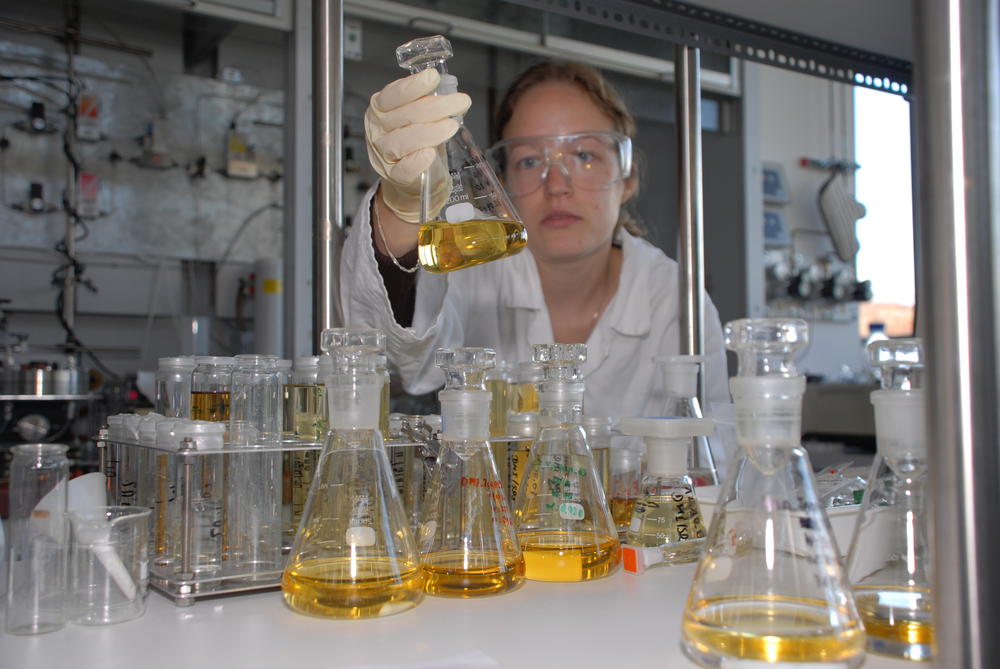Searching for Matchmakers
UniSysCat investigates complex catalytic systems for the green chemistry of the future.
Apr 25, 2019
Which factors control the coupling of enzymatic processes? In plants, processes take place with lightning speed and reliability. In UniSysCat teams are investigating catalysts that could achieve similar results in industrial production processes.
Image Credit: TU Berlin / PR
As you read this text, millions and millions of chemical reactions are taking place in your body. They ensure, for example, that your body temperature does not fluctuate too much, that your cells do not starve, that you canmove. You do not produce waste that cannot be recycled. And yet you are so unoccupied by all this that you can breathe, sit, read at the same time, and ask yourself why you should imagine the amazingly compact biochemical miracle that you are.
The insights gained by Drieß and his colleagues could herald the green chemistry era of tomorrow.
The aim is to show you the immense power of fascination as well as the complexity of the processes that concerns chemistry professor and catalysis expert Matthias Drieß from the Technische Universität Berlin. The chemist and vice spokesperson for the UniSysCat Cluster of Excellence is investigating topics such as the conditions under which different chemical reactions can take place one after the other in a very small space. The insights gained by Drieß and his colleagues in the Cluster of Excellence could herald the green chemistry era of tomorrow.
Take ammonia, for example. This is of vital importance for world nutrition, is mainly used in fertilizers, and has been obtained for just over a hundred years by means of a large-scale industrial process, the Haber-Bosch synthesis. At around 400° Celsius and 200 times atmospheric pressure, one nitrogen and three hydrogen atoms per molecule unite here, starting from molecular nitrogen and hydrogen. The process is not particularly “green” in terms of energy efficiency and sustainability.
To compare, take a look at the garden: here, nodule bacteria living in the soil are constantly converting elementary nitrogen from the air into ammonia– a vital process for the plants that benefit from it. High pressure? High temperatures? High energy consumption? Far from it. “The loosening of strong chemical bonds plays a decisive role in both processes,” explains Matthias Drieß. The background: molecular hydrogen and nitrogen do not voluntarily combine to form ammonia, neither in the reactor nor in nature, but only under the influence of so-called catalysts. Ammonia is as much a problem here as more than 85 percent of all the currently available products from the chemical industry: Catalysts line their production path, making the production of building materials, medicines, and cosmetics economical or possible in the first place.
Matthias Drieß suggests that it would be best to imagine these chemical assistants asmarriage brokers. “Catalysts dissolve previous bonds so that the reaction partners become single, then convey that new bonds are formed and emerge ‘unused’ from the process once the work is complete.” The fact that makes the “wedding” in nature greener and much less expensive: evolution has produced reaction networks that catalyze several different reactions in a very small space. In this way it conserves resources and exploits synergies.
Conventional, industrial production, on the other hand, carries out one production step after the other – in industrial plants measuring hundreds of square meters. “In a single plant cell as a reaction space, several reaction chains are coupled at lightning speed and run reliably one after the other, for which we would need a huge industrial plant for production,” explains Matthias Drieß.
“If we do it right, we’ll be able to do it better than nature.” Matthias Drieß
The importance of basic research in the field of coupled catalysis therefore cannot be emphasized enough. “In view of increasingly scarce resources, we must recycle with the aid of catalysis and use sustainable energy sources for this purpose,” emphasizes Drieß. Fossil fuels – the keyword being energy crisis – will indeed soon be running out, but solar, wind, and water energy will not. “Nostradamus’s prophecies will not come about,” the researcher assures. “Ultimately, it’s about efficiency. For me, in the long run, the artificial plant is the last resort. If we do it right, we’ll be able to do it better than nature.”
This text originally appeared on February 22, 2019, in a Tagesspiegel newspaper supplement published by Freie Universität Berlin, Humboldt-Universität zu Berlin, Technische Unversität Berlin, and Charité - Universitätsmedizin Berlin.
Further Information
UniSysCat
The UniSysCat Cluster of Excellence investigates the understanding and design of new reaction-accelerating substances in chemical and biological catalysis that set new standards in green chemistry. In five interdisciplinary research fields, the scientists are developing best practice methods for the chemical industry of the future: Whereas up to now multi-stage production has often been carried out with high energy consumption, in the future the researchers want – similarly to a biological cell – to allow several reactions to take place one after the other in a more restricted space in a controllable manner, thus massively saving resources.

